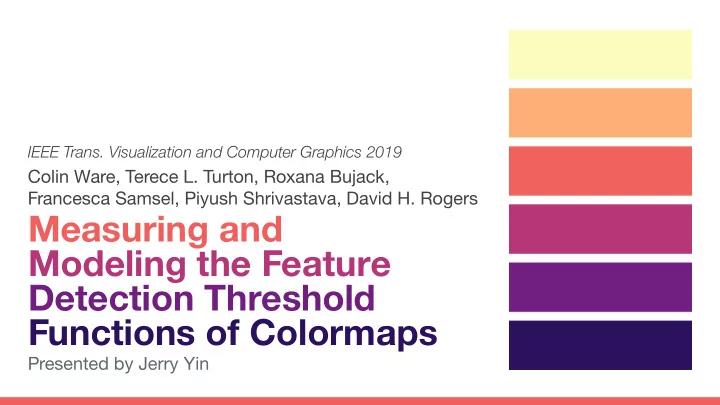

IEEE Trans. Visualization and Computer Graphics 2019 Colin Ware, Terece L. Turton, Roxana Bujack, Francesca Samsel, Piyush Shrivastava, David H. Rogers Measuring and Modeling the Feature Detection Threshold Functions of Colormaps Presented by Jerry Yin
Which colourmap is the best at visualizing the data?
Paper contributions Paper type: evaluation ● Describes way to measure frequency-dependent ● discriminative power function of a colourmap Discriminative power: ability to distinguish ○ different colours Frequency-dependent: more later ○ Defines metric for “overall discriminative power” ● across entire range of a colourmap
Spatial frequency Discriminative power depends on ● spatial frequency Uniform colour spaces (UCS) intended ● to be visually uniform Based on measurements between ○ large patches of uniform colour Thus, uniform colour spaces may not ● actually appear uniform in high- The bands visually disappear at different frequency datavis contexts! heights along the image.
Spatial frequency Discriminative power depends on ● spatial frequency Uniform colour spaces (UCS) intended ● to be visually uniform Based on measurements between ○ large patches of uniform colour Thus, uniform colour spaces may not ● actually appear uniform in high- The bands visually disappear at different frequency datavis contexts! heights along the image.
Spatial frequency Discriminative power depends on ● spatial frequency Uniform colour spaces (UCS) intended ● to be visually uniform Based on measurements between ○ large patches of uniform colour Thus, uniform colour spaces may not ● actually appear uniform in high- frequency datavis contexts!
Empirical study Paper devises empirical study for measuring ● discriminative power across multiple spatial frequencies Used 600×600px images ● For each column, participants click the area ● where the sinusoidal pattern disappears Tested nine colour sequences and three ● frequencies (10px, 15px, 45px) For each sequence, tested 30 locations ○
Tested colourmaps
Results VI viridis GR green-red GP greyscale BY blue-ylw RA rainbow CW cool-warm BOD blu-orang ECW ext. cool- warm TH thermal
Results BY blue-yellow GR green-red CW cool-warm VI viridis GP greyscale RA rainbow BOD blue-orange ECW extended cool-warm TH thermal
Results ● Ran 2-way ANOVA Arcs indicate where differ- ● ences not statistically significant Ran Tukey HSD test (ano- ● ther significance test), horizontal bars show cases where colourmaps were not BY blue-yellow RA rainbow GR green-red BOD blue-orange significantly different CW cool-warm ECW extended cool-warm VI viridis TH thermal GP greyscale
Which colourmap should I use? Despite having the ● highest discriminative power, the thermal colourmap is confusing .
Which colourmap should I use? Despite having the ● highest discriminative power, the thermal colourmap is confusing . Same also applies to ● divergent colourmaps, to some degree.
Reweighting CIELAB Discriminative power should ● correspond to distance traversed by colourmap in uniform colour space Paper describes simplistic way to ● reweight CIELAB space to take into account the measured values in the paper Equal weight is given to the ○ 10px, 15px, and 45px cases
(Own) critique Instead of reweighting CIELAB in a way that is ● good for all datasets, maybe it would be better to collect data for many frequencies and reweight based on data that is currently being plotted Minimum discriminative power may be a better ● metric than mean discriminative power Outliers were manually removed ● Sample size a bit small: only 21 - 35 participants ● per colourmap
Recommend
More recommend